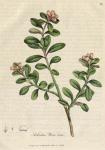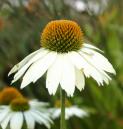
 Synonyma. Uva ursi. Pharm. Lord. & Edinb.
Synonyma. Uva ursi. Pharm. Lord. & Edinb.
Uva ursi Clus. Rarior. Plant. Hist. p. 62.
Vaccinia ursi sive Uva ursi apud Clusium. Gerard. Emac. p. 1416. J. Bauh. Hist. vol. i. p. 523. Bauh. Pin. p. 470. Park. Theat. p. 1457. Raii Synopsis, n. 457. Hist. p. 1489. sp. 5. Flor. Dan. 33. Murr. Comment. de Arbuto uva ursi. Gotting. 1764. Girardi Nova Aimadver. Patavii 1764. Sandifort Diss. tab. 8. Withering. Bot. Arr. p. 428.
Class Decandria. Ord. Monogynia. Lin. Gen. Plant. 220.
Ess. Gen. Ch. Cal. 5-partitus. Cor. ovata: ore basi pellucida. Bacca 5-locularis.
Spec. Char. A. caulibus procumbentibus, foliis integerrimis.
The root is perennial, long, branched, and fibrous: the stems are numerous, procumbent, spreading, woody, scarcely a foot in length, and seldom divided into branches: the leaves are oblong, obtuse, narrowed towards the base, entire, thick or fleshy, smooth, without footstalks, of a dingy green colour, and closely surround the upper part of the stalk: the flowers are whitish or flesh-coloured, and terminate the stems in small clusters upon short slender pedicles: the calyx is very small, and divided into five obtuse teeth: the corolla consists of a single petal, which is tubular, oval, contracted, [Our artist, by supposing the contracted state of the corolla to be merely the effect of drying, has made it appear too inflated in the annexed figure.] and divided at the margin into five minute reflexed segments: the filaments are ten, short, downy, tapering, and crowned with erect reddish anthers: the germen is oval, and placed above the insertion of the corolla: the style is tapering, longer than the filaments, and terminated with a simple stigma: the fruit is a pulpy, round, red berry. It is a native of the Northern parts of Britain, and flowers in June.
Professor Murray has not been able to determine whether this plant is the (greek), which is much commended by Galen [De comp. med. sec. loc. L. 7. c. 4. p. 548. Ed. Chart.] in cases of haemoptysis, or the (greek), used as a general astringent by Dioscorides. [Mat. Med. L. 4. c. 42. p. 482. Ed. Vergil.] It grows in great abundance in different parts of Europe and America, particularly in barren sandy foils; and that which is found in dry, lofty, and exposed situations, is preferred [Girardi l. c. p. 454.] for medical use to that which is collected in valleys and shady grounds. The leaves of this plant, in a dried state, have no remarkable smell, but a bitterish astringent taste, and by some are used for the purpose of dying an ash-colour, and for tanning leather. The sapid matter of these leaves has been attributed rather to the presence of gummy than of resinous particles, as watery menstrua extract their virtues more completely than spirituous. [Murray App, Med. vol. ii. p. 58.]
The Uva Ursi, though employed by the ancients in several diseases requiring astringent medicines, had almost entirely fallen into disuse till about the middle of the present century, when it first drew the attention of physicians as a useful remedy in calculous and nephritic affections; and in the years 1763 and 1764, by the concurrent testimonies of different authors, [De Haen, Gerhard, Quer, Girardi, Murray, Buchoz, and others.] it acquired remarkable celebrity not only for its efficacy in gravelly complaints, but in almost every other to which the urinary organs are liable, as ulcers of the kidneys and bladder, cystirrhoea, diabetes, &c. and its utility was then thought to be so fully established, that a Spanish writer [Quer. See the French version of his book, viz. Dissertation sur la maladie nephritique, et sur son veritable specifique le Raisin d'ours, p. 84.] made it his boast that the man, to whom these important discoveries of the effects of this plant ought first to be referred, was his countryman. He was however superseded in this claim by the physicians at Montpelier, who had been in the habit of prescribing Uva Ursi in these diseases for many years before. [Vide Barbeirac form. Med. p. 163.] But the cases published successively by De Haen tended more to raise the medical character of Uva Ursi over Europe than all the other books professedly written on the virtues of this plant: and encouraged by his success, many practitioners in this country have been induced to try its effects; and though the use of this plant has been frequently observed to mitigate the pains in calculous cases, yet in no instances do we find that it has produced that essential or permanent relief, which is laid to have been experienced by the German physicians. ["The trials of the Uva Ursi made in this country, have by no means answered expectation: in all the cases that have come to my knowledge it produced great sickness and uneasiness, without any apparent benefit, though continued for a month." Lewis M. M. p. 683. And in a case of Incontinence of urine, Dr. Fothergill observes, "The Uva Ursi, so much extolled of late in ulcers of the urinary passages, seemed but to aggravate the symptoms." Med. Obs. & Inquir. vol. iii, p. 144. But in the preface to this volume we are told, "that the Uva Ursi had been frequently prescribed successfully by many of the Members of the Society of Physicians in London."]
From the experiments of Dr. Alexander, [See his Exp. Essays, p. 154.] the leaves of Uva Ursi seem to possess very little diuretic power, and those made by Murray [The calculi were macerated in a strong decoction of the Uva Ursi. Vide l. c.] show that they have no material effect upon the urinary calculi: the efficacy they may therefore have in relieving the calculous diseases, we are disposed to ascribe to their astringency; and in confirmation of this opinion we may cite the observation of Dr. Cullen, who, in his chapter on Astringents, [Mat. Med. vol. it. p. 12. & seq. And Dr. Withering, speaking of the effects of this plant, says, "Perhaps, upon the whole, we shall find it no better than other vegetable astringents; some of which have long been used by the country people in gravelly complaints, and with very great advantage; though hitherto unnoticed by the regular practitioners." l. c.] notices the dissertation of De Heucher, under the title of Calculus per adstringentia pellendus: and though he does not think with this author that astringents are lithontriptics, yet from his own experience, and that of others, he believes they often have a powerful effect in relieving calculous symptoms; and in proof of this he refers to the exhibition of the Uva Ursi. The leaves may be employed either in powder or decoction; the former is most commonly preferred, and given in doses from a scruple to a dram two or three times a day.

